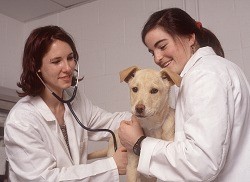Cornell veterinary students seek solution to pet overpopulation 'disease'
By Roger Segelken
Each year an estimated 12 million cats, dogs and other pets in the United States are euthanized -- not because the animals are sick but because humans have the "disease" of not caring about pet overpopulation.
In "Issues and Preventive Medicine in Animal Shelters," the first course of its kind at an American veterinary school, Cornell University's future animal doctors are discovering the extent of what their instructors call a national epidemic. The students in the College of Veterinary Medicine also are learning what enlightened animal shelters are doing about the problem (See "Smart Pet Tricks," attached) and what they, as caring professionals, can do to help.
"It has been called the disease of euthanasia," says Associate Professor of Epidemiology Janet M. Scarlett, D.V.M., Ph.D., using the clinical term for the painless killing of animals. "Animal shelters are forced to kill millions of healthy, potentially adoptable dogs and cats each year in this country. No other disease or condition of companion animals takes as many lives as euthanasia. In fact, no other disease comes close."
And veterinarians should be troubled by the problem, according to Scarlett, who co-teaches the shelter medicine class with officials of the New York-based American Society for the Prevention of Cruelty to Animals (ASPCA).
She says, "Instead of responding with an all-out effort to address and eliminate the overpopulation problem, as veterinarians did in the 1970s when parvovirus infection threatened to kill hundreds of thousand of otherwise healthy dogs, the veterinary profession as a whole has been content to leave the overpopulation problem to humane organizations to solve."
Of course many veterinarians across the U.S. volunteer their time and expertise to animal shelters, Scarlett acknowledges, "but not nearly enough of us do, perhaps because we're missing the big picture." In fact, most U.S. veterinary colleges allot very little of their curricula to the issues of overpopulation and euthanasia, Scarlett says, "and that sends the message to future veterinarians that this is not an important problem for their consideration."
Students in the shelter medicine course, which is designed by Lila Miller of the ASPCA and supported by both the ASPCA and the College of Veterinary Medicine at Cornell as an educational experiment, are getting the message. After taking the class -- which covers everything from animal-management control programs, shelter diseases and early-age neutering to the link between animal abuse and human violence -- many students volunteer their time at the local animal shelter. There they perform routine exams and vaccinations of pets that are up for adoption, under the supervision of licensed veterinarians. Others give their time to "well-pet" clinics in economically depressed areas of Ithaca.
The Cornell professor hopes that concern will continue after her students graduate. "As veterinarians, we cannot operate in a vacuum," Scarlett says. "We must remember that we deal first hand with creatures that have a real impact on society -- not just in the zoonotic diseases that are transmissible from animals to humans, but in the problem of stray animals and pet overpopulation. Companion animals play an important role in the lives of many Americans, and we must look out for their welfare."
More than anyone else, Scarlett believes, veterinarians have the power to enhance the human-animal bond. And to educate.
"We should be counseling our clients on adopting pets that are appropriate for their lifestyle and helping them resolve their pet behavioral problems," Scarlett says. "We should be telling our clients: 'Consider adopting your next pet from an animal shelter. And by all means, have that pet spayed or neutered. By adopting an unwanted pet, you will be saving one animal from the disease of euthanasia. By neutering that pet, you are avoiding many more needless deaths. "
Media Contact
Get Cornell news delivered right to your inbox.
Subscribe